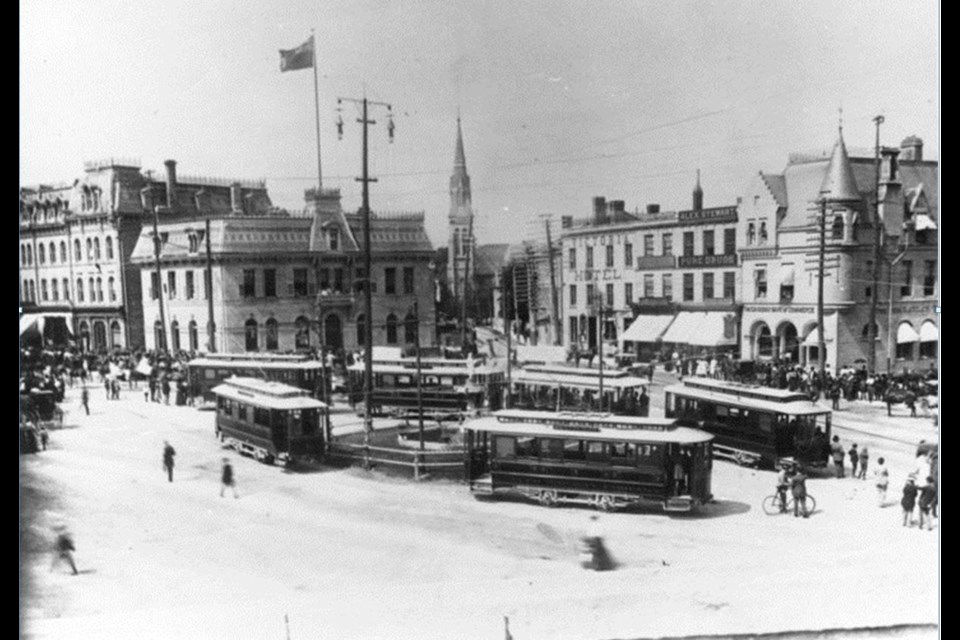Some months ago, I was walking by Wilson Street during one of its periodic bouts of non-functionality when I noticed a curious sight: a massive stack of scrap metal - rusted with age and crusted with dirt –lying forlorn beside a larger hole that had recently been a roadway. To my eyes the scrap-metal looked like rails, and I asked a worker what they were. He said, bored and disinterested, that they were leftovers from the railway bridge overhead, which struck me as nonsense – what would CNRbe doing entombing unused track under public streets? - and in any case the gage looked wrong. It wasn’t the right shape for CNR rails.
I didn’t have a camera, but I wish I’d had, because as I suspected at the time, that old scrap was the last remnants of the Downtown’s once-mightystreetcar system.
The Guelph Sub-Urban Railway was first touted in the 1870s: there was some attempt to install horse-drawn street cars as early as 1875, but the project never got the political backing it needed to really go anywhere. It wasn’t until the 1890s that George Sleeman - of the Silver Creek Brewery, the antecedent to our modern-day Sleeman Brewery – stepped in to give the project the push it needed.
Driven by a desire to give his workers a better way to get to and around the Downtown, Sleeman paid for the construction of an electric railway - the Guelph Street Railway - out of his own pocket. Construction began in 1894, and the line opened the following year, with almost seven kilometresworth of track. It had two lines: Woolwich through to Dundas Road, and Waterloo down to the big Canadian Pacific and Canadian National (then Grand Trunk) railway stations.
The system was extremely popular and over the next decade both ridership and length of track doubled in size. The line added inner-city freight trains to the street railway by 1900 to help move cargo as well as people around the Downtown. The city purchased the rail line in 1903, and later sold it to Ontario Hydro, who linked it to the existing radial line of the Toronto Suburban Railway in 1917. At that one could take the streetcar across the Downtown, transfer to the train, ride it out to Georgetown, and go from Georgetown on to Union Station every two hours – and by 1926 every hour.
Imagine that. Hourlyrail transit from Downtown Guelph to the heart of the provincial capital. Anyone who has gone abroad to Europe has come back depressed when faced with the inability of our local rail systems toget people where they want to go at convenient times, but the oldGuelph Railway Company did more than just connect one-city to another. The old railway system connected the Downtown to itself: it wasn’t merely one destination among many, it was a central hub through which constant, rapid transit was considered essential, vital to healthy economic growth.
There’s an old John Cusack film, City Hall, that features a somewhat broad translation of a quote from Pericles – “All Good Things of this Earth Flow into the City.” While Guelph of the late 19th and early 20th century wasn’t quite as robust as ancient Athens (though it was less plague-ridden), the builders of both envisioned a future where all good things flowed into the city, into its centre: for Athens, the famed Acropolis, for Guelph, its downtown. If you look at pictures of the Downtown from that era, you can see that centrality everywhere you look: its shops, its stables, its multiple hotels. It was the heart of Guelph’s most important places, where all good things flowed.
The Guelph Radial Line was shuttered in 1931, the street car system in 1937. The Great Depression had done a number on their finances, and the rise of buses and personal automobiles gutted ridership, making the idea of dedicated rail lines for such a small area seem old-fashioned. At the time the change made sense, but it was an early sign that the minds of people were changing: they were ceasing to perceive the Downtown as being the heart of Guelph, it was merely one more part of it.
The Downtown has never ceased to be the centrepiece of public life – it’s the fulcrum on which civic engagement turns – but Guelphites have often seemed to forget this all-important fact. We need to remind ourselves of time when the movement of shoppers up and down Wilson Street was considered as important as transit to Toronto, and where getting around the Downtown was as necessary as getting around the province – because Downtown is the place to be.
It’s not about transit, it’s about mindset. The All-Day, 2-Way Go, for example, would be a glorious revival of our past: current estimations of a 2030 delivery date is a likely sign that no one is taking this as seriously as they should. In Guelph, all good things flow into the city, into our centre – good food, great shops, unique events – and its high-time our city planning reflects that again.
(The writer would like to thank Tony Berto for his expert advice in untangling the oft-baroque history of Guelph suburban rail.)
James Campbell-Prager was commissioned by the Downtown Guelph Business Association to write this article.
This Content is made possible by our Sponsor; it is not written by and does not necessarily reflect the views of the editorial staff.

